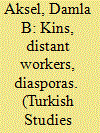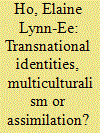|
|
|
Sort Order |
|
|
|
Items / Page
|
|
|
|
|
|
|
| Srl | Item |
| 1 |
ID:
142707


|
|
|
|
|
| Summary/Abstract |
This article examines the cosmopolitan world of the colonial zenana through the marriages of two mid-twentieth-century royal Indian women, Maharani Brijraj Kumari of Dhrangadhra and Maharani Krishna Kumari of Jodhpur. In particular, it analyses the close connection between zenana women's education and emergent adolescent sexuality. These women ordinarily began their studies in mixed-gender classrooms with their brothers and male cousins as children. As they neared the age of menarche, girls were extracted from the formal schoolroom and undertook instruction in household management and childcare in preparation for their expected roles as wives and mothers. Despite being prematurely cut off from the childhood classroom, women's educational backgrounds (in both Western and Indic forms of knowledge) and future learning potential remained an important part of their postmarital identity. Young, anglicized Indian men increasingly desired wives who reflected the modernity that they hoped to represent as imperial subjects and were encouraged to adopt by British advisors and tutors. They required wives who would not wear pardah and thus reflect more Western ideals of companionate marriages of friendship, yet simultaneously live in gender-segregated palace quarters, uphold traditional kinship networks, perform religious duties, and engage in the maintenance of a large polygamous household. Definitions of sex, marriage, and domesticity were increasingly cross-cultural and pan-historical in nature, incorporating aspects both of the ‘modern’ and the ‘traditional’, the Indic and the European, the regional and the transnational.
|
|
|
|
|
|
|
|
|
|
|
|
|
|
|
|
| 2 |
ID:
132524


|
|
|
|
|
| Publication |
2014.
|
| Summary/Abstract |
This paper analyzes the politics of the Turkish state about "Turks abroad" as a process of defining the status of and constructing the perceptions about its transnational members. Falling back on transnationalism and diaspora studies, it aims to bring together the policies of the Turkish state regarding emigrants and co-ethnics who have been stranded during the collapse of the empire from which the modern state emerged. From the point of view of the sending state/external homeland, it compares the different trajectories and policies which have been put in place during different periods, and traces the parallel actions which have been taken over the last two decades regarding both constellations. The paper also investigates the way in which the extra-territorial membership is constructed and defined-by putting emphasis on its fluidity over time as a result of endogenous and exogenous factors.
|
|
|
|
|
|
|
|
|
|
|
|
|
|
|
|
| 3 |
ID:
112137


|
|
|
|
|
| Publication |
2012.
|
| Summary/Abstract |
Around 1930, at a time of rising nationalisms in China and India, English-educated Chinese and Indians in the British colony of Singapore debated with great intensity the issue of national identity. They sought to clarify their own position as members of ethnic communities of immigrant origin, while remaining individuals who identified the territory of British Malaya as their home. Readers' letters published in the Malaya Tribune, an English-medium newspaper founded to serve the interests of Anglophone Asians, questioned prevailing assumptions of how to define a nation from the perspectives of territory, political loyalty, race, and language. Lived circumstances in Malaya proved that being Chinese or Indian could encompass a range of political, cultural, and linguistic characteristics, rather than a homogenous identity as promoted by nationalist movements of the time. Through these debates, Chinese and Indians in Malaya found ways to simultaneously reaffirm their ethnic pride as well as their sense of being 'Malayan'.
|
|
|
|
|
|
|
|
|
|
|
|
|
|
|
|
| 4 |
ID:
139681


|
|
|
|
|
| Summary/Abstract |
This article investigates the tensions that emerge when transnational identities are juxtaposed against claims of multiculturalism and de facto assimilation processes. The article focuses on the resettlement of co-ethnics who arrived in China through forced migration between 1949 and 1979 and the generational transitions of their descendants. The Chinese state resettled these forced migrants from Southeast Asia on state-owned farms known as the ‘overseas Chinese farms’ and gave them preferential treatment as ‘returnees’ rather than ‘refugees’. They retained transnational cultural identities which set them apart from the China-born Chinese and suffered further stigmatization during the Cultural Revolution. This article highlights the limitations of using ethnicity as a lens for understanding how ‘difference’ is negotiated in China. In contemporary times the (multi)cultural identities of the refugee-returnees are promoted for the purposes of tourism to help reinvent the farms for economic sustainability. Yet the identity transitions experienced by the children and grandchildren of the refugee-returnees suggest that they are assimilating a national identity that subsumes their overseas Chinese cultures, serving to normalize a Chinese identity associated with the locally born Chinese instead. The article argues that the objectification of overseas Chinese heritage and assimilation ideology work together to selectively highlight China's historical connections to its co-ethnics abroad while simultaneously projecting a new national narrative of contemporary Chinese identity that is distinct from the overseas Chinese. This article on Chinese forced migration and resettlement provides useful insights concerning the negotiation of transnational identity with respect to multiculturalism and assimilation, and further suggests new directions for overseas Chinese studies today.
|
|
|
|
|
|
|
|
|
|
|
|
|
|
|
|
|
|
|
|
|